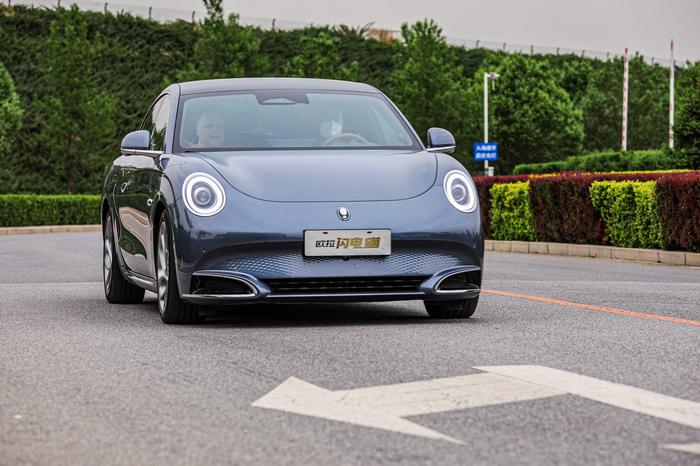2024 Ora Lightning Cat Saloon Review

We get an early drive in Ora's follow up to the Funky Cat.
Ora's Funky Cat follow-up is the sleek Lightning Cat.
Review
The motoring landscape, particularly the electric car market, is undergoing a dramatic change. Not only is there a glut of new EVs arriving on sale, but several new brands have also appeared, many of which hail from China — the world's largest electric car market. Following the re-introduction of MG was Ora, a subsidiary of Great Wall Motor Co, with its unusually named Funky Cat. Later this year, the model line-up will expand with the arrival of a second model, called the Lightning Cat, and we've been driving it in its native China.
What is the Ora Lightning Cat?
The Lightning Cat is a fully electric saloon similar in profile to the Hyundai Ioniq 6 and Mercedes-Benz CLS, adopting a sleek and sloping roofline for enhanced aerodynamics. You'll be forgiven for thinking there's something familiar about the Ora's looks. Its exterior design is a pastiche of the Porsche Panamera’s with some Bentley elements thrown in for good measure. It's not lacking in premium features either, such as frameless doors, 19-inch alloy wheels as standard and an electrically operated boot spoiler that rises at speed.
Powering the Lightning Cat is a sizeable 82kWh battery and a dual-motor setup with a power output of up to 408hp, generating 680Nm of torque. That's enough for a 0-100km/h dash that takes just 4.3 seconds before heading to a top speed of 180km/h. In WLTP conditions, it has a driving range of 430 kilometres and can recharge from 0-80 per cent in 55 minutes.
Don't get too hung up on the name, though, as it's likely that by the time it reaches European shores, Ora may switch to a new naming structure for its models that will see this car called simply the ‘07’.
What about the interior?
If you thought there was a hint of Porsche on the outside, you should look inside as it’s a familiar and surprisingly high-quality layout. A 10.25-inch digital display is housed behind a three-section instrument binnacle that provides all the relevant driving info. Next to that is a free-standing 12.3-inch central touchscreen for the infotainment system.
Ora's native system isn't initially as intuitive to use as some competitor systems, but the availability of Android and Apple smartphone mirroring software easily remedies that. Meanwhile, the blend of leather and metallic materials gives the Lightning Cat a stylish cabin. The central spine, which acts as a centre console, features a minimalist design with some simple rocker switches and three rotary dials for temperature and fan speed adjustment. Central air vents are located directly below the screen, making them less obvious. Behind that is an open storage area with USB ports for charging devices.
Despite its plunging roofline, there is plenty of rear passenger space, including headroom. Both outer rear seats offer plenty of legroom, and the full-length panoramic glass roof increases the airy feeling in the back.
What's it like to drive the Ora Lightning Cat?
Our first taste of the Lightning Cat came at Ora's Research and Development Centre in the company's home city of Boading in China. The dual-motor setup propels the Ora forward with all the instantaneous torque we've come to expect from electric cars, and even beyond 100km/h it continues to pull strongly. The contoured front seats do a reasonably good job of holding you in place when the corners arrive too.
You can cycle through the different drive modes by using the rotary dial at the base of the cabin's central spine, making it easy to adjust on the move. In its Sport setting, the car pumps a synthesised digital V6 sound into the cabin, which could fool some passengers into thinking there's a combustion engine under that short bonnet.
The steering has a positive feel, providing reasonable levels of feedback to the driver’s inputs. Through faster bends, the supple suspension does result in some body lean, more than one would experience in cars such as a BMW 5 Series, though it doesn't lack composure in day-to-day driving scenarios. However, it is worth noting that the car we drove used a suspension setup specific to the Chinese market, whereas European-bound models will receive a different calibration.
Sound suppression is good, while premium brand tyres help grip levels, handling and road noise.
While it does have plenty of performance on tap, the Lightning Cat is more of a comfortable cruiser than sporty saloon, and taking that approach to driving it delivers an enjoyable experience.
What else does Ora have planned?
Following the introduction of the Lightning Cat (or whatever name Ora settles on using for it), the company intends to add a mid-size SUV to its range. We've yet to see what that model will look like, but it is believed to have styling designed specifically to appeal to European tastes. That will round out the initial rollout of the Ora brand, and beyond that, any further expansion of the range will depend on the success of these models.



